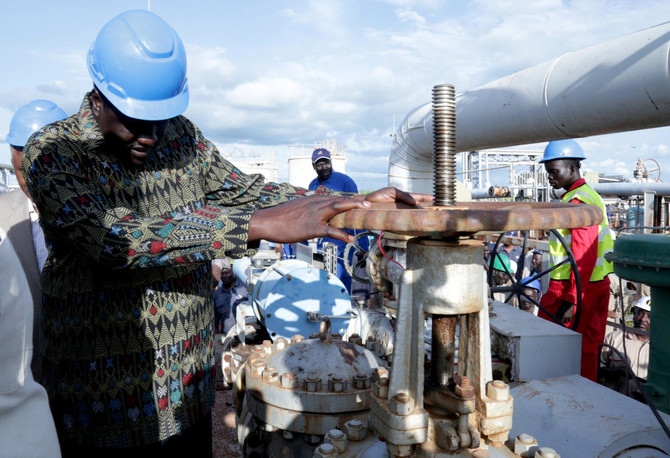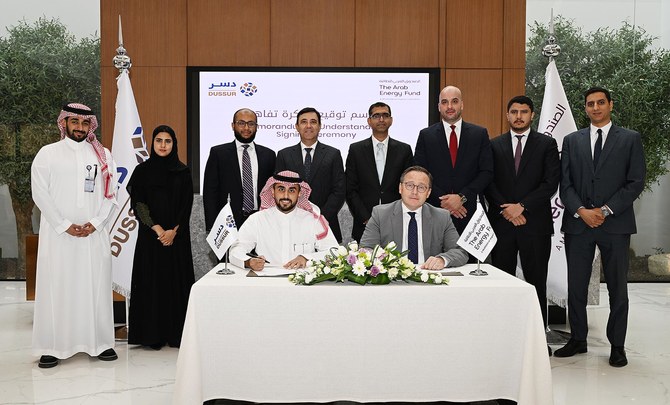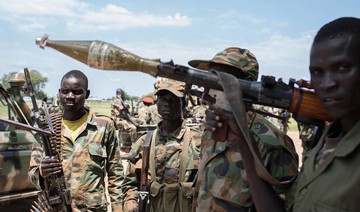KHARTOUM: South Sudan has resumed pumping 20,000 barrels per day (bpd) of crude from the Toma South oilfield, where production had been suspended since 2013, the Sudanese oil minister Azhari Abdulqader said. Production at five of the previously suspended oilfields was expected to reach 80,000 bpd after maintenance work is completed by the end of the year, Abdulqader told a news conference in Khartoum.
South Sudan’s oil output currently stands at 130,000 bpd and is expected to reach 210,000 bpd by year-end, he added.
South Sudan seceded from Sudan in 2011 when output peaked at 350,000 bpd but two years later plunged into civil war. At the time fighting started, production was at about 245,000 barrels per day.
The conflict has killed tens of thousands, displaced an estimated quarter of South Sudan’s population of 12 million and ruined its economy that heavily relies on crude oil production.
South Sudan’s oil is shipped to international markets via a pipeline through Sudan.
The area in which Toma South oilfields lie saw the most intense fighting between rebels and government troops, damaging oil production facilities.
During a visit on Saturday to Toma South, some 20 miles to the border with Sudan, Ezekiel Lol Gatkuoth, South Sudan’s Oil Minister, said the resumption of production in blocks 1, 2 and 4, will bring an additional output of 45,000 barrels per day.
He said the operator of the fields, Greater Nile Petroleum Operation Company, and staff from his ministry were working to ensure full production.
“They will be here in Toma South working seven days a week, 24 hours a day to make sure that the production is not interrupted and also to make sure the central processing facility is operational,” Gatkuoth said.
The return to production and pumping is part of a cease fire and power-sharing agreement that was reached earlier this month when President Salva Kiir, rebel leader Riek Machar and other rebel groups signed a peace deal meant to end the civil war. “I can tell everyone, the production can be more if peace is there and if we are determined to nourished it,” Abdulqader said.
South Sudan resumes pumping 20,000 bpd from oilfield suspended since 2013
South Sudan resumes pumping 20,000 bpd from oilfield suspended since 2013

- Production at five of the previously suspended oilfields was expected to reach 80,000 bpd after maintenance work is completed
- South Sudan’s oil is shipped to international markets via a pipeline through Sudan
Baheej unveils waterfront development project in Yanbu

RIYADH: Saudi Arabia’s tourism sector continues to expand, with Baheej Tourism Development Co. unveiling a new waterfront development project in Yanbu.
This joint venture between ASFAR, a Saudi tourism investment company owned by the Public Investment Fund, and the Tamimi-AWN Alliance, aims to develop the waterfront area of the Royal Commission at Yanbu.
The initial project will cover 32,000 sq. m. and feature three leisure assets: a beach, a tourist activation center, and a hotel. It is set for complete unveiling in 2027.
A fourth component is scheduled to be announced at a later date.
According to a release, each aspect of the project aims to provide memorable and sustainable tourism experiences.
Visitors will soon have the opportunity to explore Yanbu, a city with a rich history dating back to the 16th century, renowned for its architectural heritage and sandy beaches.
Baheej envisions Yanbu as an iconic location that showcases Saudi Arabia’s culture, history, and natural beauty, providing a unique destination to tourists.
Nora Al-Tamimi, CEO of Baheej, outlines the project’s development in three phases, emphasizing community engagement, sustainability, and minimal environmental impact.
Al-Tamimi said: “We believe that destinations are not just built but discovered, and Baheej’s commitment lies in uncovering Saudi Arabia’s hidden gems. Our strategic collaborations are aimed at curating unparalleled experiences that showcase Saudi Arabia’s rich culture, history, and natural wonders.”
She added: “Yanbu City’s contemporary infrastructure, captivating environment, and attractive coastal landscapes make it an exceptional gateway to the Red Sea Riviera. We anticipate the complete unveiling of our destination and its components by the end of 2027.”
By analyzing risks and investment opportunities, the project aims to position Yanbu as a locally and internationally sought-after tourist destination, explained Al-Tamimi.
Baheej’s role will involve integrating local culture and promoting protection of the planet, enhancing Yanbu’s appeal and supporting regional development.
This approach aims to transform Yanbu’s hospitality sector, blending community heritage with environmental stewardship.
Established in 2023, Baheej aims to create accessible tourism experiences that meet international standards while remaining contextual and sustainable.
These initiatives are part of a broader strategy to transform Saudi towns into thriving, eco-friendly destinations.
Baheej also plans to announce additional projects in other cities by the end of 2024.
Saudi banks’ money supply surges 8% in March to reach $753bn

RIYADH: Saudi banks’ money supply rose 8 percent in March, as compared to the same month last year, to reach SR2.82 trillion ($753 billion), official data showed.
According to the data released by the Saudi Central Bank, also known as SAMA, the increase was mainly fueled by a roughly 21 percent surge in banks’ term and savings accounts, reaching SR843.25 billion. These deposits represented the second-largest portion, comprising 30 percent of the total money supply, following demand deposits, which constituted 50 percent at SR1.41 trillion.
On the other hand, quasi-money holdings made up 21 percent of the total, experiencing a 1 percent decrease during this period. Meanwhile, currency outside banks accounted for an 8 percent share, showing a 10 percent growth.
Multiple factors influenced the upsurge in term deposits. Firstly, the elevated interest rate environment within the Kingdom, shaped by the US Federal Reserve’s anti-inflationary monetary policy, has spurred individuals and entities to seek higher returns through these accounts.
Moreover, the increase in accounts held by government-related entities played a significant role. As per Fitch Ratings, these entities opted to channel their surplus liquidity into term deposits with commercial banks, thereby boosting the growth trajectory of such accounts.
It is noteworthy that during 2022, SAMA raised key policy rates seven times, followed by an additional four increases in 2023. The central bank’s repo rate was last raised by 25 basis points to 6 percent in its July 2023 meeting, marking its highest level since 2001. Since then, rates have remained unchanged.
Meanwhile, US inflation surged to a six-month high in March, prompting investors to delay their expectations for Federal Reserve rate cuts.
Deposits represent a costly funding source for banks, with heightened competition in the financial market significantly driving up their average cost.
Despite this, the surge in interest rates also strengthened Saudi banks’ profits on the asset side. Higher borrowing rates led to increased income, offsetting the challenges posed by the expensive funding environment.
On the asset side, Saudi bank loans grew by 11 percent during this period to reach SR2.67 trillion; therefore, lending growth among Saudi banks outpaced deposits.
In their April report, S&P Global suggested that Saudi financial institutions would explore alternative funding strategies to manage the rapid increase in lending, driven by rising demand for new mortgages.
The credit-rating agency noted that the funding profiles of financial institutions in the Kingdom will undergo changes, mainly due to a government-supported initiative aimed at boosting homeownership.
According to their analysis, mortgage financing accounted for 23.5 percent of Saudi banks’ total credit allocation by the end of 2023, compared to 12.8 percent in 2019.
They highlighted that the ongoing financing needs of the Vision 2030 economic initiative, coupled with relatively sluggish deposit growth, are likely to prompt banks to seek alternative budget sources, including external funding.
S&P Global anticipated this trend to persist, especially as corporate lending assumes a more significant role in growth in the coming years.
The report indicated that Saudi banks are expected to adopt alternative funding strategies to support this expansion. It also noted that the stability of Saudi deposits mitigates the risk posed by maturity mismatch.
Furthermore, the agency projected an increase in Saudi banks’ foreign liabilities, rising from approximately $19.2 billion by the end of 2023, to meet the funding demands of robust lending growth, particularly amidst slower deposit expansion.
The report emphasized that Saudi banks have already tapped into international capital markets, and S&P Global anticipates this trend to continue over the next three to five years.
Saudi aviation sector contributes $21bn to GDP: GACA

RIYADH: Saudi Arabia is experiencing steady growth in its aviation sector, contributing $21 billion to the Kingdom’s gross domestic product in 2023 and solidifying its position as a global tourism hub.
The General Authority for Civil Aviation stated that the aviation industry is creating positive impacts in other key areas of Saudi Arabia’s economy, with the sector responsible for a further $32.2 billion in tourism receipts, according to a press statement.
GACA added that the aviation industry alone has enabled 241,000 jobs in the Kingdom and has contributed to supporting 717,000 jobs in tourism-related areas.
The authority revealed that the nation outperformed global aviation sector growth rates in 2023, achieving 123 percent of international pre-pandemic seat capacity compared with a worldwide and regional average recovery rate of 90 percent and 95 percent, respectively.
GACA will present these findings in an analysis titled “2024 State of Aviation Report” at the Future Aviation Forum on May 20.
Saudi Arabia’s Minister of Transport and Logistics Services and Chairman of GACA, Saleh Al-Jasser, said: “The Saudi aviation sector is providing unprecedented opportunities for global aviation, achieving major leaps in global rankings in support of Vision 2030 and in line with the National Strategy for Transport and Logistics services.”
Saudi Arabia’s National Transport and Logistics Strategy seeks to increase the industry’s contribution to the Kingdom’s GDP to 10 percent from the current 6 percent by 2030.
“The inaugural State of Aviation report highlights the contribution that the aviation sector makes to the Saudi society and economy, with the great support from the Custodian of the Two Holy Mosques and His Highness the Crown Prince,” added Al-Jasser.
Abdulaziz Al-Duailej, president of GACA, said that the Kingdom is building a more resilient, connected, high-performing aviation sector across various verticals, including airlines, airports, cargo and logistics, and human capability and training systems.
“GACA has developed this report to fulfill its role as a strategic aviation regulator, measuring and recording the progress of the sector in line with the targets of the Saudi Aviation Strategy. The report also informs GACA’s ongoing regulatory work and the impacts of new regulations in creating greater competition, value, and choice in Saudi Aviation,” said Al-Duailej.
During the Future Aviation Forum, Saudi Arabia is expected to unveil a roadmap detailing how the Kingdom will grow its aviation sector tenfold into a $2 billion industry by 2030.
This year’s gathering will bring together more than 5,000 sector experts and leaders from more than 100 countries to discuss ways to shape the future of international air travel and freight management.
The Arab Energy Fund and Dussur sign $200m MoU to boost greenfield energy projects

RIYADH: Greenfield energy projects are set to receive a boost, as The Arab Energy Fund has signed a $200 million funding agreement with the Saudi Arabian Industrial Investments Co.
A memorandum of understanding was executed between the energy-focused financial institution TAEF and the Saudi-based industrial investment and development company, also known as Dussur.
This deal aims to fast-track and facilitate prospective financing opportunities for TAEF through bridge financing in selected greenfield projects promoted by Dussur.
Nicolas Thevenot, chief banking officer at TAEF, said: “We are thrilled to sign this MoU with Dussur and enter an era of collaboration to support the advancement of the flourishing energy sector in Saudi Arabia.”
He added: “Our strategic partnership with Dussur is also aligned with our planned investment of up to $1 billion to advancing the energy transition with a focus on decarbonization and related technologies over the next five years.”
The MoU contributes to the Kingdom’s efforts to advance industrialization and economic diversification by defining a broad framework agreement between TAEF and Dussur.
“Dussur is pleased to have signed this MoU with TAEF, which could unveil multiple collaborative opportunities to maximize Dussur’s impact on the Saudi economy,” said Omar Al-Qarawi, director of finance and accounting at Dussur.
He added: “Through this MoU, Dussur and TAEF aim to further their joint efforts to leverage strategic and sustainable industrial investments.”
In February, the Public Investment Fund-backed Dussur launched an oilfield services and industrial chemicals factory in Jubail in collaboration with Bakers Hughes, a Texas-based oilfield services provider.
The Saudi Petrolite Chemicals facility is expected to increase the Kingdom’s supply base of raw materials such as solvents and glycols.
It is intended to accelerate the development of the skills and capabilities of Saudi human resources in manufacturing, thus contributing to the increase in localization rates and the rapid delivery of chemical solutions.
The opening ceremony was attended by Saudi Energy Minister Prince Abdulaziz bin Salman, Investment Minister Khalid Al-Falih, and Minister of Industry and Mineral Resources Bandar Alkhorayef.
Saudi Arabia prioritizes real estate sector with 18 legislative initiatives to drive growth

RIYADH: The Saudi government is prioritizing the real estate sector, enacting over 18 pieces of legislation to drive its growth and significantly boost its gross domestic product.
This initiative was highlighted during the recently concluded second edition of the Saudi Exhibition for Real Estate Development and Ownership, or SEREDO, held in Jeddah. The event aimed to raise awareness, explore development opportunities, and review investment potential in the sector.
According to Tayseer bin Mohammed Al-Mufarrij, spokesman for the Real Estate General Authority, over 18 legislations have been issued to date. These include real estate systems, executive regulations, and regulatory rules, reflecting the government’s commitment to this sector as part of Vision 2030.
He emphasized the sector’s role and contribution to the Kingdom’s GDP, reaching 5.9 percent in the fourth quarter of 2023. He also noted that the property sector’s contribution to the country’s non-oil activities was 12.1 percent, as reported by the Saudi Press Agency.
During the expo, Abdullah bin Saud Al-Duhaim, general supervisor of property development at REGA, provided a detailed explanation of the new system for selling and leasing off-plan real estate projects and its recently approved executive regulations.
In a workshop on the sidelines of the event, Al-Duhaim and other officials outlined the procedural steps for applying for qualification, obtaining licenses to practice the activity, and the requirements for developers to register with the authority.
They also underscored the importance of complying with the regulations and legislation governing the sector, which aim to provide high-quality services, enhance reliability, increase transparency, and protect the rights of all stakeholders.
REGA’s participation in SEREDO 2024 is part of its role in raising awareness about real estate, exploring development opportunities, showcasing investment prospects, and exchanging experiences with industry professionals, SPA added.
It also aims to engage the community in creating solutions to challenges, advancing toward future horizons that enhance the prosperity and sustainability of the real estate market.
This approach seeks to make the sector dynamic and capable of adapting to rapid changes, which aligns with Vision 2030 objectives.
The real estate development and ownership field in the Kingdom is considered one of the largest growing sectors in the Middle East. Its volume is estimated at approximately $69.51 billion in 2024 and is expected to reach $101.62 billion by 2029, recording a compound annual growth rate of 8 percent.















